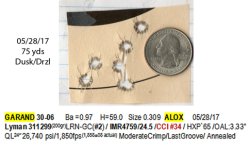disseminator
New member
Hey guys,
So I'm looking into some loads for my 357 SIG using a Speer 125 TMJ and the max load listed in my Speer reloading manual is given as 11.2C of vvN105
Imputing this into Quickload says it will be a load density of 116.3%!
I've loaded a bunch of compressed loads before so that's nothing new but 116.3% seems like a LOT of compression.
What do you think?
So I'm looking into some loads for my 357 SIG using a Speer 125 TMJ and the max load listed in my Speer reloading manual is given as 11.2C of vvN105
Imputing this into Quickload says it will be a load density of 116.3%!
I've loaded a bunch of compressed loads before so that's nothing new but 116.3% seems like a LOT of compression.
What do you think?

